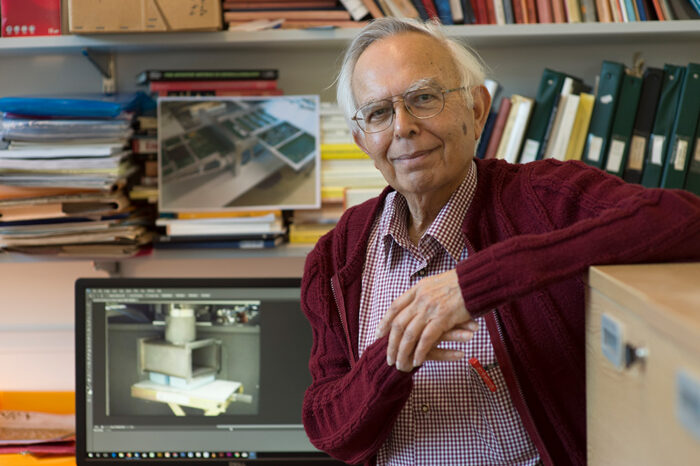
Wasi (Abdul Raffey) Faruqi, from the LMB’s Structural Studies Division, has been made a MBE in the Queen’s 2021 Birthday Honours List, for services to medical research.
Wasi joined the LMB in 1969 to work on position-sensitive detectors and microdensitometers for X-ray diffraction, before moving on to the development of semiconductor detectors for electron microscopy (EM). His work has put him at the forefront of instrumentation developments in structural biology, both within the LMB and in the wider scientific community.
Wasi graduated with a first-class honours degree in Physics with Mathematics from Sind University, Hyderabad, India in 1957, and after a MSc in Physics at the Punjab University, Lahore, Pakistan, moved to Imperial College London to undertake a PhD in High Energy Physics. In 1965, he worked for a year as a Senior Scientific Officer at the Pakistan Atomic Energy Commission in Lahore and then returned to Imperial College London to become a Research Fellow in the Physics Department, before joining the LMB in Cambridge.
In the 1970s, during the early phase of synchrotron radiation development, Wasi collaborated with Hugh Huxley’s group in the design of instrumentation for recording the low-angle fibre pattern from contracting muscle with high time resolution. This work included the development of low angle X-ray cameras as well as detectors. Preliminary evaluation was carried out at the NINA electron synchrotron at the then Daresbury Nuclear Physics Laboratory, UK. Wasi was also involved in the development of several position sensitive detectors, such as the Multiwire Linear Detector at the X7 Beamline at Daresbury.
From about 1990, Wasi’s main focus switched from X-rays to the development of semiconductor detectors for EM, in collaboration with Richard Henderson, with a goal of completely replacing film for measurements in EM. Along with LMB colleagues, David Cattermole, Howard Andrews and Steve Stubbings, the first type of detector Wasi developed was based on low noise charged coupled devices (CCDs), originally designed for use in astronomical observations. CCDs can only be used in an indirect mode because they are damaged by any direct interaction. The spatial resolution in these devices is restricted but is still excellent for recording electron diffraction patterns.
The next step was to develop direct electron detection and Wasi, along with the particle physics community, was involved in the evolution of several types of silicon detectors with positional sensitivity. In collaboration with the Medipix Group, based at the European Organisation for Nuclear Research, known as CERN, Switzerland, Wasi evaluated the properties of the hybrid pixel detectors, Medipix1 and Medipix2, for use in electron microscopy. These detectors were also developed for use at the Large Hadron Collider at CERN. Wasi was also centrally involved in the design and production of a second type of direct detector, a Monolithic Active Pixel Sensor (MAPS), fabricated using complementary metal oxide semiconductor (CMOS) technology, in collaboration with the Rutherford Appleton Laboratory, Harwell, Oxfordshire and the FEI Company (now Thermo Fisher). This was the first commercially successful CMOS direct electron detector for cryo-EM. Direct electron detectors increased the attainable resolution by cryo-EM dramatically and led to the resolution revolution that now makes cryo-EM the most powerful structural biology technique and helped the LMB’s Richard Henderson win the 2017 Nobel Prize in Chemistry.
Wasi retired as a Group Leader in 2007, but continued as a “retired worker” until 2020, bringing his unique skills to the LMB’s current EM detector development projects. He also contributed to many other EM-related projects. From 1992, he served as a member of the national organising committee for an international series of conferences on position sensitive radiation imaging detectors, and from 1999 was a member of the project management committee for the Medipix collaboration of 17 European institutes, based at CERN.
Richard Henderson, LMB Nobel laureate 2017, commented: “It is wonderful and fitting that Wasi and his outstanding contributions to structural biology and to the LMB have been recognised in this way. Wasi’s detector physics background and decades of experience in detector design and validation for X-ray crystallography, and later cryo-EM, meant that the LMB had in-house skill and expertise, which has been the key to effective collaborations with the physics and engineering groups elsewhere.”